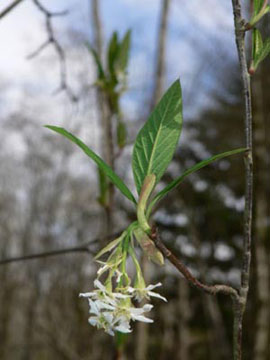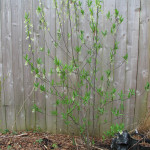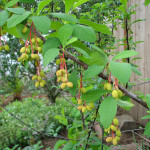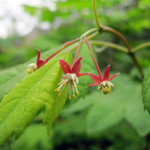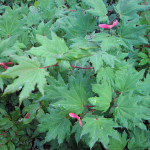Oemleria cerasiformis
Osoberry is a fast-growing, multi-stemmed shrub to small tree with reddish to purplish-brown bark. In open sunny locations it may form a dense shrub, while in the shade it becomes more open to sprawling. This is one of our earliest flowering native shrubs, and its slender, lime-green leaves are one of the first signs that spring is on the way!
This woodland plant does best in moist areas with dappled shade, and can tolerate many soil types, including heavy clay.
In the early spring, both male and female osoberries produce dangling clumps of whitish flowers. Female plants will then produce small hard berries towards the end of summer (male plants produce no fruit). The fruit is peach-colored early in the season, maturing to blue-black in the fall, and is a favorite of many birds and small mammals. Osoberry also serves as a host for several caterpillar species, and the flowers are a source of nectar for butterflies, hummingbirds, and pollinators, making this an excellent wildlife plant.
- Light Requirements: Full Sun, Part Shade, Full Shade
- Water Requirements: Dry, Moist
- Ease of Growing: Easy to grow
- Growth Rate: Fast
- Spreads: No
- Wildlife Support: Birds or Mammals
- Fire-resistant: Yes
- Edible: Yes
- Mature Height: 15ft
- Mature Width:5-10ft
Blue Elderberry

Sambucus cerulea
Blue elderberry (Sambucus cerulea) is a large, fast-growing deciduous shrub or small tree featuring showy clusters of creamy-white flowers that mature into large clusters of blue-black berries.
This shrub is a great addition to your wildlife garden. Many birds eat the berries, and butterflies visit the flowers for nectar. The plant provides food for the young of spring azure butterflies and various moths. Native solitary bees shelter and lay their eggs in the hollow twigs. Dead elder wood is also the preferred habitat of the mushroom Auricularia auricula-judae, also known as Judas’ ear fungus or wood ear fungus.
Blue elderberry can get quite tall, reaching up to 15 feet in height. Plant it in sun to part shade in well drained soils.
- Light Requirements: Full Sun, Part Shade
- Water Requirements: Dry, Moist
- Ease of Growing: Easy to grow
- Growth Rate: Fast
- Spreads: No
- Wildlife Support: Pollinators, Pest-eating Insects, Birds or Mammals
- Fire-resistant: Yes
- Edible: Yes, but parts of the plant toxic
- Mature Height: 10-25ft
- Mature Width:18ft
Pacific Crabapple

Malus fusca
Pacific crabapple (Malus fusca) is found in Western Oregon and north through Washington State into Canada and Alaska. It prefers moist woods and is often found at the edges of wetlands. It’s the perfect tree for a wet corner of the garden.
In spring, crabapples bloom with fragrant clusters of pinkish-white blossoms. By mid-summer, 3/4″ long fruits appear. The crabapples turn yellow to reddish in the fall, and often hang on the tree all winter, providing both visual interest and food for wildlife. The leaves of this showy tree also turn orange and bright red in autumn, binging lovely fall color to any garden.
The flowers attract large numbers of native bees including mason bees and bumblebees, and butterflies lay their eggs on the leaves. The fruits are a favorite of birds and small mammals, and the dense foliage provides both food and cover for wildlife.
Pacific crabapple grows best in full sun and moist to wet soils. Plant it with other wet-loving natives such as serviceberry, red osier dogwood, and Pacific ninebark for year-round color and wildlife habitat!
- Light Requirements: Full Sun, Part Shade
- Water Requirements: Moist, Seasonally Wet
- Ease of Growing: Moderate
- Growth Rate: Moderate
- Spreads: No
- Wildlife Support: Pollinators, Hummingbirds, Pest-eating Insects, Birds or Mammals
- Fire-resistant: Yes
- Edible: Yes
- Mature Height: 30ft
- Mature Width:25ft
Vine Maple
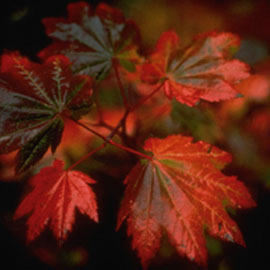
Acer circinatum
Vine maple (Acer circinatum) commonly grows as a large open shrub or small tree reaching 10-25 feet tall. It typically grows in the shady forest understory but is sometimes found out in the open. Like many plants, it typically gets taller in the shade and stays more compact in the sun.
Like all maples, the branches and leaves grow in pairs off the stem, known as “opposite branching.” Leaves are 3-14 cm long and broad, and thinly hairy on the underside. They are palmately lobed with 7-11 lobes, which are pointed with coarsely toothed margins. The flowers make a small but dramatic show in spring, blooming a bright red and whitish-green from May – June. The fruit is a two-seeded winged fruit called a samara, starting green then turning reddish-brown as they ripen. The leaves turn bright yellow to orange-red in fall and provide some of our most vivid native fall color.
Vine maples are important trees for wildlife. They provide nesting sites and cover for many birds and mammals. Vireos weave basket-like nests that hang in the forks of the branches. Birds use the seed stalks and leaves for nest building. Squirrels, chipmunks and birds eat the seeds, and the caterpillars of the brown tissue moth and Polyphemus moth forage on the leaves.
Vine maple grows best in part shade and moist soils. It can live out in the open but exposed leaves may burn and turn reddish in the afternoon sun. This is a beautiful specimen plant for a shady corner, or a tall screen to soften the side of a house. Pair it with snowberry and ferns for year-round interest.
- Vine maple is fire-resistant – remember, though, being fire-resistant does not mean it will not burn!
- Light Requirements: Full Sun, Part Shade, Full Shade
- Water Requirements: Moist
- Ease of Growing: Easy to grow
- Growth Rate: Moderate
- Spreads: No
- Wildlife Support: Pollinators, Pest-eating Insects, Birds or Mammals
- Fire-resistant: Yes
- Edible: No
- Mature Height: 20-25ft
- Mature Width:15-20ft

